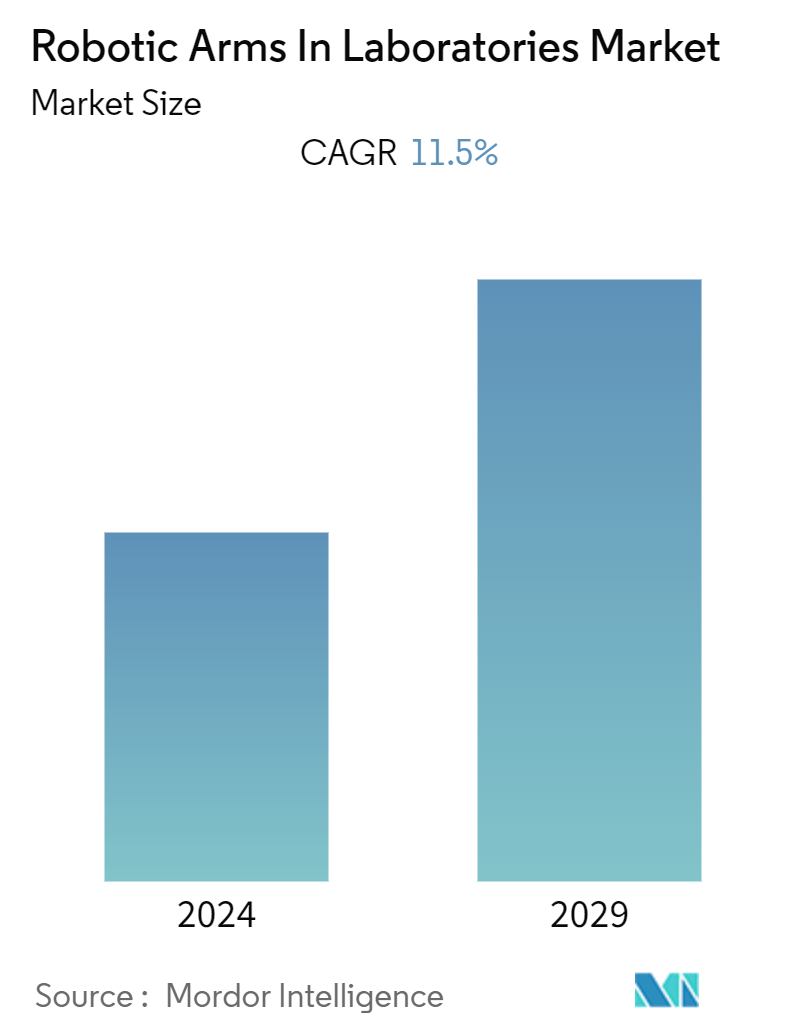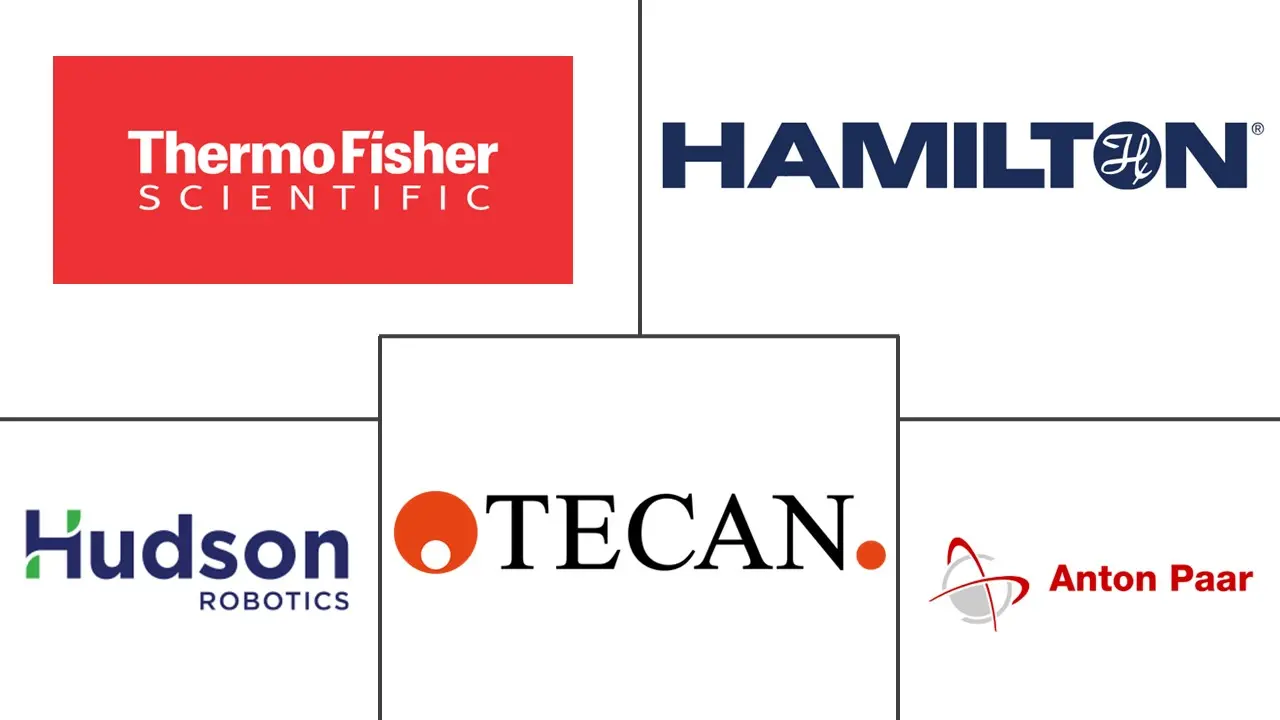Market Size of Robotic Arms In Laboratories Industry

| Study Period | 2019 - 2029 |
| Base Year For Estimation | 2023 |
| CAGR (2024 - 2029) | 11.50 % |
| Fastest Growing Market | Asia Pacific |
| Largest Market | North America |
| Market Concentration | Medium |
Major Players
*Disclaimer: Major Players sorted in no particular order |
Laboratory Robotic Arm Market Analysis
The Robotic Arms In Laboratories Market is expected to register a CAGR of 11.5% during the forecast period.
Robotic arms are rapidly being used in research laboratories for applications that need flexibility, effective space use, and seamless integration of lab peripherals. With the simplicity with which the arms may be programmed, the adoption has expanded over time. Preparing samples, running analytical equipment, and handling sample material are typical duties these robots do. As a result, lab automation is the primary driver of laboratory robotic arm use.
- Robotic arms are widely used in assay development, cell biology, bioassay validation, DNA quantification, PCR setup, and cleanup. These are optimized for handling standard labware, like microplates, reservoirs, and disposable tip racks. These are also helpful for loading and unloading microplate-based lab instruments, such as readers, washers, and reagent dispensers.
- Further, biomedical research has employed robotic arms primarily to process samples. Their influence in the drug discovery process remained limited, which explains why the development, testing, and commercialization process takes 15 to 20 years on average. Recent improvements in laboratory automation and robotics, particularly in AI and ML, have created a new frontier in life science and pharmaceutical. Tasks can now be completed at rates and precision that exceed human competence.
- For instance, the FDA's Center for Drug Evaluation and Research (CDER) recently approved 50 brand-new pharmaceutical and biological products. 33 of the 50 novel medications and biological products approved for usage had tiny molecules, while 17 were monoclonal antibodies and other large molecules. However, the number of biological approvals has constantly risen during the past few years. Such huge approvals for drugs will drive the studied market.
- Furthermore, due to its apparent benefits, including stability, high precision, repeatability, many degrees of freedom, mobility, and remote control, collaborative robotic arms have been used with medical imaging and operations for a while. In many surgical procedures, robotic surgery is now a reality. According to National Health Service (United Kingdom), 43.3 million imaging tests were reported between April 2021 and March 2022 in England. 3.67 million imaging tests were said to have been performed in March 2022. The most prevalent type of imaging in March 2022 was plain radiography (X-rays), with 1.82 million cases, followed by diagnostic ultrasound (0.85 million), computerized axial tomography (CT-scan), and magnetic resonance imaging (0.56 million).
- Moreover, more tests are being sent to the lab due to a higher number of patients and an increasing number of tests available. However, the need for more staff to process these samples leaves medical facilities needing help. According to the Bureau of Labor Statistics, the demand for lab workers is growing. For instance, the American Association of Medical Colleges (AAMC) predicted that by 2030 there would be a shortage of 42,600 and 121,300 clinicians by the end of the following decade. This would drive the demand for the studied market.
- Furthermore, the Russia-Ukraine war is impacting the supply chain of electronic components. The dispute has disrupted the supply chain, causing shortages and price increases for raw materials, affecting robotic arms manufacturers and potentially leading to higher costs for end-users.
Laboratory Robotic Arm Industry Segmentation
A robotic arm is a mechanical, programmable device that manipulates objects like a human arm. Various medical institutions apply robotic arms to drive innovations in the healthcare industry. Robotic arms can prepare blood tests and medications in labs, assist in physical therapy, etc.
The robotic arms in laboratories market is segmented by Type (articulated arm, dual arm, parallel link arm), application (drug discovery, digital imaging, genomics & proteomics, clinical diagnostics, system biology), and geography (North America, Europe, Asia Pacific, Rest of the World). The report offers market forecasts and size in value (USD) for all the above segments.
| By Type | |
| Articulated Arm | |
| Dual Arm | |
| Parallel Link Arm | |
| Others |
| By Application | |
| Drug Discovery | |
| Digital Imaging | |
| Genomics & Proteomics | |
| Clinical Diagnostics, | |
| System Biology | |
| Others |
| By Geography*** | |
| North America | |
| Europe | |
| Asia | |
| Australia and New Zealand | |
| Latin America | |
| Middle East and Africa |
Robotic Arms In Laboratories Market Size Summary
The laboratory robotic arm market is experiencing significant growth, driven by the increasing demand for automation in research and clinical settings. These robotic arms are becoming integral in various applications such as assay development, cell biology, and DNA sequencing, offering benefits like high precision, repeatability, and the ability to handle complex tasks with ease. The advancements in artificial intelligence and machine learning have further enhanced the capabilities of these robotic systems, allowing them to perform tasks with greater speed and accuracy than human operators. This trend is particularly evident in the pharmaceutical and biomedical sectors, where robotic arms are used to streamline processes such as drug discovery and clinical trials, thereby reducing the time and cost associated with these activities.
The market is also influenced by the growing need for efficient laboratory operations due to an increase in patient tests and a shortage of skilled lab personnel. Collaborative robotic arms are being integrated into medical imaging and surgical procedures, enhancing the precision and efficiency of these operations. The United States, with its robust pharmaceutical industry and numerous contract research organizations, remains a key player in the market, fostering innovation and adoption of robotic technologies. Additionally, geopolitical factors like the Russia-Ukraine conflict are impacting the supply chain of electronic components, affecting the availability and cost of robotic arms. Major industry players are actively engaging in partnerships and acquisitions to expand their product offerings and maintain a competitive edge in this rapidly evolving market.
Robotic Arms In Laboratories Market Size - Table of Contents
-
1. MARKET INSIGHTS
-
1.1 Market Overview
-
1.2 Value Chain Analysis
-
1.3 Industry Attractiveness - Porter's Five Forces Analysis
-
1.3.1 Threat of New Entrants
-
1.3.2 Bargaining Power of Buyers
-
1.3.3 Bargaining Power of Suppliers
-
1.3.4 Threat of Substitute Products
-
1.3.5 Intensity of Competitive Rivalry
-
-
1.4 Assessment of Impact of Macroeconomic Trends on the Market
-
-
2. MARKET SEGMENTATION
-
2.1 By Type
-
2.1.1 Articulated Arm
-
2.1.2 Dual Arm
-
2.1.3 Parallel Link Arm
-
2.1.4 Others
-
-
2.2 By Application
-
2.2.1 Drug Discovery
-
2.2.2 Digital Imaging
-
2.2.3 Genomics & Proteomics
-
2.2.4 Clinical Diagnostics,
-
2.2.5 System Biology
-
2.2.6 Others
-
-
2.3 By Geography***
-
2.3.1 North America
-
2.3.2 Europe
-
2.3.3 Asia
-
2.3.4 Australia and New Zealand
-
2.3.5 Latin America
-
2.3.6 Middle East and Africa
-
-
Robotic Arms In Laboratories Market Size FAQs
What is the current Robotic Arms in Laboratories Market size?
The Robotic Arms in Laboratories Market is projected to register a CAGR of 11.5% during the forecast period (2024-2029)
Who are the key players in Robotic Arms in Laboratories Market?
Thermo Fisher Scientific Inc., Hamilton Company, Hudson Robotics, Inc., Tecan Group and Anton Paar GmbH are the major companies operating in the Robotic Arms in Laboratories Market.

